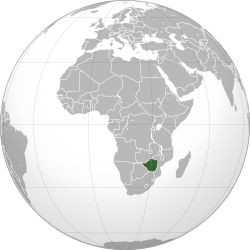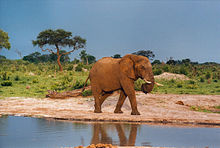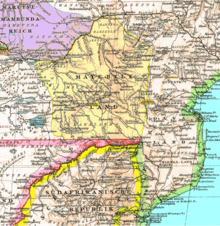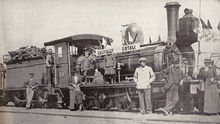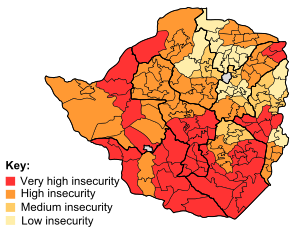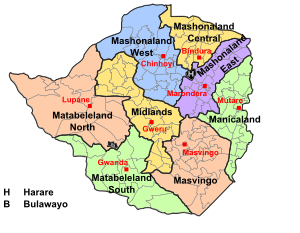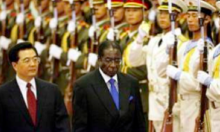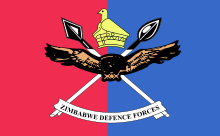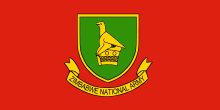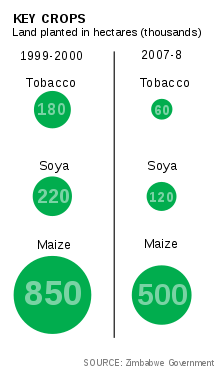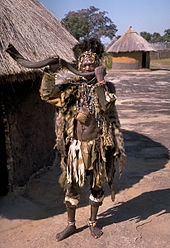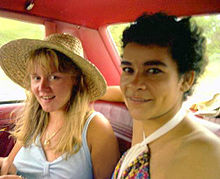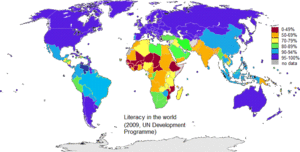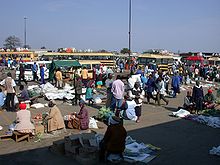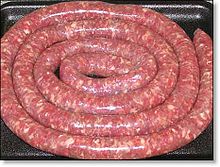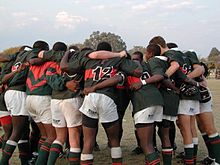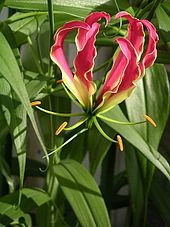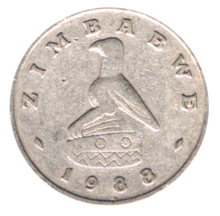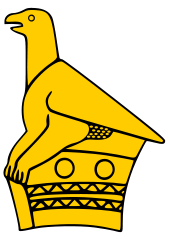
Zimbabwe
Background to the schools Wikipedia
This Schools selection was originally chosen by SOS Children for schools in the developing world without internet access. It is available as a intranet download. Sponsor a child to make a real difference.
| Republic of Zimbabwe | ||||||
|---|---|---|---|---|---|---|
|
||||||
| Motto: "Unity, Freedom, Work" | ||||||
| Anthem: Simudzai Mureza wedu WeZimbabwe ( Shona) Kalibusiswe Ilizwe leZimbabwe ( Sindebele) Blessed be the land of Zimbabwe |
||||||
|
|
||||||
| Capital and largest city |
Harare 17°50′S 31°3′E |
|||||
| Official languages |
|
|||||
| Ethnic groups (2003) |
|
|||||
| Demonym | Zimbabwean | |||||
| Government | Semi-presidential republic | |||||
| - | President | Robert Mugabe | ||||
| - | Prime Minister | Morgan Tsvangirai | ||||
| - | Vice President | Joice Mujuru | ||||
| - | Deputy Prime Ministers | Thokozani Khuphe Arthur Mutambara |
||||
| Legislature | Parliament | |||||
| - | Upper house | Senate | ||||
| - | Lower house | House of Assembly | ||||
| Independence from the United Kingdom | ||||||
| - | Declared | 11 November 1965 | ||||
| - | Recognized | 18 April 1980 | ||||
| - | Current constitution | 21 December 1979 | ||||
| Area | ||||||
| - | Total | 390,757 km2 ( 60th) 150,871 sq mi |
||||
| - | Water (%) | 1 | ||||
| Population | ||||||
| - | 2012 estimate | 12,619,600 ( 72nd) | ||||
| - | Density | 26/km2 ( 170th) 57/sq mi |
||||
| GDP ( PPP) | 2011 estimate | |||||
| - | Total | $6.127 billion | ||||
| - | Per capita | $487 | ||||
| GDP (nominal) | 2011 estimate | |||||
| - | Total | $9.323 billion | ||||
| - | Per capita | $741 | ||||
| Gini (2009) | 50.1 high |
|||||
| HDI (2011) | low · 173rd |
|||||
| Currency | variousa | |||||
| Time zone | Central Africa Time ( UTC+2) | |||||
| - | Summer ( DST) | not observed ( UTC+2) | ||||
| Drives on the | left | |||||
| Calling code | +263 | |||||
| ISO 3166 code | ZW | |||||
| Internet TLD | .zw | |||||
| a. | The Zimbabwean dollar is no longer in active use after it was officially suspended by the government due to hyperinflation. The United States dollar ($), South African rand (R), Botswana pula (P), Pound sterling (£) and Euro (€) are now used instead. The United States dollar has been adopted as the official currency for all government transactions. | |||||
Zimbabwe ( / z ɪ m ˈ b ɑː b w eɪ / zim-BAHB-way), officially the Republic of Zimbabwe, is a landlocked country located in Southern Africa, between the Zambezi and Limpopo rivers. It is bordered by South Africa to the south, Botswana to the southwest, Zambia to the northwest and Mozambique to the east. The capital is Harare. Zimbabwe achieved de jure sovereignty from the United Kingdom in April 1980, following 14 years as an unrecognised state under the conservative white minority government of Rhodesia, which unilaterally declared independence in 1965.
Zimbabwe has three official languages: English, Shona and Sindebele. The present territory was first demarcated by Cecil Rhodes of the British South Africa Company, becoming a self-governing colony as Southern Rhodesia in 1923. President Robert Mugabe is head of state and commander-in-chief of the armed forces; Morgan Tsvangirai is the serving Prime Minister. Once renowned across the continent as a champion for the anti-colonial cause, Mugabe is now viewed as a repressive authoritarian responsible for human rights abuses and severe economic decline. He has held office since Zimbabwe's internationally recognised independence in 1980.
Etymology
Zimbabwe was formerly known as Southern Rhodesia (1923), Rhodesia (1965), and Zimbabwe Rhodesia (1979). The name Zimbabwe was introduced from ca. 1960 in the context of the potential name of the country once independent, and used by the African nationalist factions in the Second Chimurenga, the most major of which were the Zimbabwe African National Union (led by Robert Mugabe from 1975), and the Zimbabwe African People's Union, led by Joshua Nkomo from its founding in the early 1960s.
The name is based on a Shona name for a ruined ancient city whose remains are now a protected site. It is officially referred to as Great Zimbabwe, and was first recorded as Symbaoe in 1531 by Vicente Pegado, Captain of the Portuguese garrison of Sofala.
There are two theories on the origin of the word "Zimbabwe". Various sources hold that the word is derived from dzimba-dza-mabwe, translated from the Karanga dialect of Shona as "large houses of stone" (dzimba = plural of imba, "house"; mabwe = plural of bwe, "stone"). The Karanga-speaking Shona people are found around Great Zimbabwe in the modern-day province of Masvingo. Archaeologist Peter Garlake claims that "Zimbabwe" is a contracted form of dzimba-hwe which means "venerated houses" in the Zezuru dialect of Shona, and is usually applied to chiefs' houses or graves.
Geography and environment
Zimbabwe is a landlocked country in southern Africa, lying between latitudes 15° and 23°S, and longitudes 25° and 34°E. Most of the country is elevated in the central plateau (high veld) stretching from the southwest to the northwest at altitudes between 1,200 and 1,600 m. The country's east is mountainous with Mount Nyangani as the highest point at 2,592 m. About 20% of the country consists of the low veld under 900m. Victoria Falls, one of the world's biggest and most spectacular waterfalls, is located in the country's northwest as part of the Zambezi river. The country has a tropical climate with a rainy season usually from late October to March. The climate is moderated by the altitude. Zimbabwe is faced with recurring droughts; and severe storms are rare.
Flora and fauna
The country is mostly savanna, although the moist and mountainous east supports tropical evergreen and hardwood forests. Trees include teak and mahogany, knobthorn, msasa and baobab. Among the numerous flowers and shrubs are hibiscus, spider lily, leonotus, cassia, tree wisteria and dombeya.
There are around 350 species of mammals that can be found in Zimbabwe. There are also many snakes and lizards, over 500 bird species, and 131 fish species.
Environmental issues
Large parts of Zimbabwe were covered by forests with an abundant wildlife. Poverty, population growth and lack of fuel have led to extensive deforestation, which, along with poaching, has reduced the wildlife. Deforestation and woodland degradation are a major concern and have led to erosion and land degradation which diminish the amount of fertile soil. Zimbabwe is a country that relies mostly on hydroelectric power. Zimbabwe had once relied heavily on electricity from Mozambique and other neighboring countries, but due to the accumulation of debt Mozambique has cut off power supply to Zimbabwe. This has caused ZESA, Zimbabwe's main electricity supplier, to begin excessive load shedding all over Zimbabwe with some urban areas only having electricity three days a week. Thus the amount of deforestation has increased as the population in urban areas has also started using firewood for fuel whereas before it was mainly the rural population due to lack of electricity in the rural areas. Despite all this, Zimbabwe's climate, along with Malta's, has been ranked highly on the index for the best climate to live in by some prestigious organisations.
History
Pre-colonial era (1000–1886)
Proto-Shona speaking societies first emerged in the middle Limpopo valley in the 9th century before moving on to the Zimbabwean highlands. The Zimbabwean plateau eventually became the centre of subsequent Shona states, beginning in ca. the 10th century. Around the early 10th century, trade developed with Arab merchants on the Indian Ocean coast, helping to develop the Kingdom of Mapungubwe in the 11th century. This was the precursor to the more impressive Shona civilisations that would dominate the region during the 13th to 15th centuries, evidenced by ruins at Great Zimbabwe, near Masvingo, and other smaller sites. The main archaeological site is a unique dry stone architecture.
The Kingdom of Mapungubwe was the first in a series of sophisticated trade states developed in Zimbabwe by the time of the first European explorers from Portugal. They traded in gold, ivory and copper for cloth and glass.
From about 1300 until 1600, Mapungubwe was eclipsed by the Kingdom of Zimbabwe. This Shona state further refined and expanded upon Mapungubwe's stone architecture, which survives to this day at the ruins of the kingdom's capital of Great Zimbabwe. From c. 1450–1760, Zimbabwe gave way to the Kingdom of Mutapa. This Shona state ruled much of the area that is known as Zimbabwe today, and parts of central Mozambique. It is known by many names including the Mutapa Empire, also known as Mwene Mutapa or Monomotapa as well as "Munhumutapa," and was renowned for its stategic trade routes with the Arabs and Portugal. Eventually, however, the Portuguese sought to monopolise this influence and began a series of wars which left the empire in near collapse in the early 17th century.
As a direct response to increased European presence in the interior, a new Shona state emerged, known as the Rozwi Empire. Relying on centuries of military, political and religious development, the Rozvi (which means "destroyers") expelled the Portuguese from the Zimbabwean plateau by force of arms. They continued the stone building traditions of the Zimbabwe and Mapungubwe kingdoms while adding muskets to their arsenal and recruiting a professional army to defend recent conquests.
Around 1821, the Zulu general Mzilikazi of the Khumalo clan successfully rebelled from King Shaka and created his own clan, the Ndebele. The Ndebele fought their way northwards into the Transvaal, leaving a trail of destruction in their wake and beginning an era of widespread devastation known as the Mfecane. When Dutch trekboers converged on the Transvaal in 1836, they drove the tribe even further northward. By 1838, the Rozwi Empire, along with the other petty Shona states were conquered by the Ndebele and reduced to vassaldom.
After losing their remaining South African lands in 1840, Mzilikazi and his tribe permanently settled the southwest of present-day Zimbabwe in what became known as Matabeleland, establishing Bulawayo as their capital. Mzilikazi then organised his society into a military system with regimental kraals, similar to those of Shaka, which was stable enough to repel further Boer incursions. Mzilikazi died in 1868 and, following a violent power struggle, was succeeded by his son, Lobengula.
Colonial era (1888–1965)
In the 1880s, white colonists arrived with Cecil Rhodes's British South Africa Company (BSAC). In 1888, Rhodes obtained a concession for mining rights from King Lobengula of the Ndebele peoples. He presented this concession to persuade the government of the United Kingdom to grant a royal charter to the company over Matabeleland, and its subject states such as Mashonaland as well.
Rhodes used this document in 1890 to justify sending the Pioneer Column, a group of Europeans protected by well-armed British South Africa Police (BSAP) through Matabeleland and into Shona territory to establish Fort Salisbury (now Harare), and thereby establish company rule over the area. In 1893 and 1894, with the help of their new Maxim guns, the BSAP would go on to defeat the Ndebele in the First Matabele War. Rhodes additionally sought permission to negotiate similar concessions covering all territory between the Limpopo River and Lake Tanganyika, then known as "Zambesia".
In accordance with the terms of aforementioned concessions and treaties, mass settlement was encouraged, with the British maintaining control over labour as well as precious metals and other mineral resources. In 1895 the BSAC adopted the name " Rhodesia" for the territory, in honour of Rhodes. In 1898 " Southern Rhodesia" became the official denotation for the region south of the Zambezi, which later became Zimbabwe. The region to the north was administered separately and later termed Northern Rhodesia (now Zambia).
Shortly after Rhodes' disastrous Jameson Raid on the South African Republic, the Ndebele rebelled against their white rulers, led by their charismatic religious leader, Mlimo. The Second Matabele War lasted until 1897, when Mlimo was murdered. Shona agitators also staged unsuccessful revolts (known as Chimurenga) against company rule during 1896 and 1897. Following these failed insurrections, the Ndebele and Shona groups were finally subdued by the Rhodes administration, which organised the land with a disproportionate bias favouring Europeans, thus displacing many indigenous peoples.
Southern Rhodesia became a self-governing British colony in October 1923, subsequent to a 1922 referendum. Rhodesians served on behalf of the United Kingdom during World War II, mainly in the East African Campaign against Axis forces in Italian East Africa. Proportional to the white population, Southern Rhodesia contributed more per capita to both the First and Second World Wars than any other part of the Empire, including Britain itself.
In 1953, in the face of African opposition, Britain consolidated the two Rhodesias with Nyasaland (Malawi) in the ill-fated Central African Federation, which was essentially dominated by Southern Rhodesia. Growing African nationalism and general dissent, particularly in Nyasaland, persuaded Britain to dissolve the Union in 1963, forming three separate divisions. While multiracial democracy was finally introduced to Northern Rhodesia and Nyasaland, however, Southern Rhodesians of European ancestry continued to enjoy minority rule.
With Zambian independence, Ian Smith's Rhodesian Front (RF) dropped the designation "Southern" in 1964 and issued a Unilateral Declaration of Independence (commonly abbreviated to "UDI") from the United Kingdom on 11 November 1965, intent on effectively repudiating the recently adopted British policy of " no independence before majority rule". It was the first such course taken by a British colony since the American declaration of 1776, which Smith and others indeed claimed provided a suitable precedent to their own actions.
Independence and civil war (1965–1979)
After UDI, the British government petitioned the United Nations for sanctions against Rhodesia pending unsuccessful talks with the Smith regime in 1966 and 1968. In December 1966, the organisation complied, imposing the first mandatory trade embargo on an autonomous state. These sanctions were expanded again in 1968.
The United Kingdom deemed the Rhodesian declaration an act of rebellion, but did not re-establish control by force. A guerilla war subsequently ensued when Joshua Nkomo's Zimbabwe African People's Union (ZAPU) and Robert Mugabe's Zimbabwe African National Union (ZANU), supported actively by neighbouring African nations, initiated guerilla operations against the white government.
Ian Smith's formation of a republic in 1970 was recognised only by South Africa, then governed under apartheid. Meanwhile, Rhodesia's internal conflict intensified, eventually forcing him to open negotiations with the militant nationalists.
In March 1978, Smith reached an accord with three African leaders, led by Bishop Abel Muzorewa, who offered to leave the white population comfortably entrenched in exchange for the establishment of a biracial democracy. As a result of the Internal Settlement, elections were held in April 1979, concluding with the United African National Council (UANC) carrying a majority of parliamentary seats. On 1 June 1979, Muzorewa, the UANC head, became prime minister and the country's name was changed to Zimbabwe Rhodesia. The internal settlement left control of the police, security forces, civil service and judiciary in settler hands. It also reserved one-third of the seats in parliament for whites. On 12 June, the United States Senate voted to lift economic pressure on the former Rhodesia.
Following the fifth Commonwealth Heads of Government Meeting (CHOGM), held in Lusaka, Zambia from 1 to 7 August in 1979, the British government invited Muzorewa, Mugabe, and Nkomo to participate in a constitutional conference at Lancaster House. The purpose of the conference was to discuss and reach an agreement on the terms of an independence constitution, and provide for elections supervised under British authority allowing Zimbabwe Rhodesia to proceed to legal independence.
With Lord Carrington, Secretary of State for Foreign and Commonwealth Affairs of the United Kingdom, in the chair, these discussions were mounted from 10 September to 15 December in 1979, producing a total of 47 plenary sessions. On 21 December 1979, delegations from every major interest represented reached the Lancaster House Agreement, effectively ending the guerilla war.
Post-Independence (1980–1999)
Britain's Lord Soames was appointed governor to oversee the disarming of revolutionary fighters, the holding of elections and the granting of independence to an uneasy coalition government with Joshua Nkomo presiding. During the elections of February 1980, Robert Mugabe and his ZANU secured a landslide victory.
Opposition to what was perceived as a Shona takeover immediately erupted around Matabeleland. In November 1980 Enos Nkala made some inflammatory remarks directed at Mugabe's party during a rally near Bulawayo. This, unfortunately, was later deemed to have caused the first Entumbane uprising, which resulted in clashes between Nkomo and Mugabe supporters.
In February 1981, there was a second uprising, which swiftly spread to Glenville and also to Connemara in the Midlands. White police reservists and former Rhodesian security troops were deployed to restore order, which they only accomplished after three hundred lives had been lost.
The Matabele unrest led to what has become known as 'Gukurahundi' ( Shona: "the early rain which washes away the chaff before the spring rains") or the Matabeleland Massacres, which lasted from 1982 until 1985. Mugabe ordered his North Korean-trained Fifth Brigade to occupy Matabeleland, crushing any resistance to his rule. It has been estimated that at least 20,000 Matabele were murdered and tens of thousands of others were tortured in military internment camps. The slaughter only ended after Nkomo and Mugabe reached a unity agreement in 1988 that merged their respective parties, creating the Zimbabwe African Union-Patriotic Front.
Zimbabwean elections in March 1990 resulted in another victory for Mugabe and his party, which claimed 117 of the 120 contested seats. Observers estimated voter turnout at only 54% and found the campaign to be "neither free nor fair".
During the 1990s, students, trade unionists, and workers often demonstrated to express their growing discontent with increasingly despotic Mugabe rule. Students protested in 1990 against proposals for an increase in government control of universities and again in 1991 and 1992, clashing with law enforcement. The unions also criticised the government during this time. In 1992, national police prevented workers from staging anti-regime demonstrations. Widespread industrial unrest which continued into 1994, however, weakened Zimbabwe's sagging economy. In 1996, civil servants, nurses, and junior doctors went on strike over salary issues. The general health of the civilian population also began to significantly founder. By 1997 an estimated 25% of the population of Zimbabwe had been infected by HIV.
Economic difficulties and hyperinflation (1999–2008)
Land issues, which the liberation movement had promised to solve, re-emerged as the main issue for the ruling party around 1997. Despite majority rule and the existence of a "willing-buyer-willing-seller" land reform programme since the 1980s, white Zimbabweans continued to hold about 70% of the most arable land. Robert Mugabe began to forcibly redistribute this land to his associates in 2000. The legality and constitutionality of the process has regularly been challenged in the Zimbabwean High and Supreme Courts.
While it is widely acknowledged that the land upheaval brought about much destruction, joblessness, hunger, and political violence, some 58,000 independent black farmers have since experienced limited success in reviving the gutted cash crop sectors through efforts on a smaller scale. Advocates of the ruling party have used this pretext to indicate that some measure of racial equality was achieved despite chaotic circumstances, claiming that black citizens must "come first" in Zimbabwe.
Mandatory confiscation of white farmland was affected by continuous droughts, as well as a serious lacking in inputs and finance, leading to a sharp decline in agricultural exports, which was traditionally the country's leading export-producing sector. As a result, Zimbabwe experienced a severe hard-currency shortage that led to hyperinflation and chronic shortages in imported fuel and consumer goods.
Charged with committing numerous human rights abuses and running the economy of his own nation into the ground, Mugabe found himself beset with a wide range of sanctions imposed by the US government and European Union against his person and Zimbabwe at large.
In 2002, the nation was suspended from the Commonwealth of Nations due to the reckless farm seizures and blatant election tampering. The following year, Zimbabwean officials voluntarily terminated its Commonwealth membership.
Following fraudulent elections in 2005, the government initiated " Operation Murambatsvina", an effort to crack down on illegal markets and slums emerging in towns and cities. This action has been widely condemned by opposition and international figures, who attest to the fact that it has left a substantial section of urban poor homeless. The Zimbabwean government has described the operation as an attempt to provide decent housing to the population, although authorities have yet to properly substantiate their claims.
Zimbabwe's economic and food crisis, described by some observers as the country's worst humanitarian crisis since independence, has been attributed in varying degrees to the government's price controls and farm confiscations, the HIV/AIDS epidemic, and a drought affecting the entire region.
Life expectancy at birth for males in Zimbabwe dramatically declined since 1990 from 60 to 42 years, among the lowest in the world. The amount of time a Zimbabwean citizen was expected to live in good health from birth was 39 years in 2010. Concurrently, the infant mortality rate has climbed from 53 to 81 deaths per 1,000 live births in the same period. As of 2009, 1.2 million Zimbabweans live with HIV.
On 29 March 2008, Zimbabwe held a presidential election along with a parliamentary election. The three major candidates were Robert Mugabe, Morgan Tsvangirai of the Movement for Democratic Change – Tsvangirai (MDC-T), and Simba Makoni, an independent. The results of this election were withheld for two weeks, after which it was generally acknowledged that the MDC had achieved a majority of one seat in the lower house of parliament.
In late 2008, problems in Zimbabwe reached crisis proportions in the areas of living standards, public health (with a major cholera outbreak in December) and various basic affairs. Mugabe's mining of diamonds at Marange in Chiadzwa became the subject of international attention as the World Diamond Council called for a clampdown on smuggling and illegal miners were reported killed by the military.
2008–present
In September 2008, a power-sharing agreement was reached between Tsvangirai and President Mugabe, permitting the former to hold the office of prime minister. Due to ministerial differences between their respective political parties, the agreement was not fully implemented until 13 February 2009.
In November 2010, the IMF described the Zimbabwean economy as "completing its second year of buoyant economic growth after a decade of economic decline", briefly citing "strengthening policies" and "favorable shocks" as main reasons for the economic growth. By December, however, Mugabe was threatening to completely expropriate remaining privately owned companies in Zimbabwe unless "western sanctions" were lifted, claiming, "Why should we continue having companies and organisations that are supported by Britain and America without hitting back? Time has come for us to [take] revenge. We can read the riot act and say this is 51 percent we are taking and if the sanctions persist we are taking over 100 percent."
Journalist Nicholas D. Kristof reported that life continues to be considerably worse for the majority of the nation than under the Rhodesian Front, despite minor improvements since 2009. Other studies, including a 2011 survey by Freedom House, remain more optimistic, suggesting that living conditions have improved on a wider front since the power-sharing agreement. The United Nations Office for the Coordination of Humanitarian Affairs states in its 2012–2013 planning document that the "humanitarian situation has improved in Zimbabwe since 2009, but conditions remain precarious for many people".
Since May 2012, the European Union initiated a new commercial partnership agreement with Madagascar, Mauritius, Seychelles and Zimbabwe. The agreement engages the EU to remove import taxes and quota on products coming from Zimbabwe and the other countries mentioned above. In return, Zimbabwe and the other countries annul import taxes and quota on products coming from the EU.
On January 17, 2013, the Vice President John Nkomo died of cancer at St Anne's Hospital in Harare, Zimbabwe at the age of 78. The current Vice President of Zimbabwe, Joice Mujuru, remains the only person to have this position in the Zimbabwean government. All of the former vice presidents have died in office.
Administrative divisions
Zimbabwe has a centralised government and is divided into eight provinces and two cities with provincial status, for administrative purposes. Each province has a provincial capital from where official business is usually carried out.
| Province | Capital |
|---|---|
| Bulawayo | Bulawayo |
| Harare | Harare |
| Manicaland | Mutare |
| Mashonaland Central | Bindura |
| Mashonaland East | Marondera |
| Mashonaland West | Chinhoyi |
| Masvingo | Masvingo city |
| Matabeleland North | Lupane District |
| Matabeleland South | Gwanda |
| Midlands | Gweru |
The names of most of the provinces were generated from the Mashonaland and Matabeleland divide at the time of colonisation: Mashonaland was the territory occupied first by the British South Africa Company Pioneer Column and Matabeleland the territory conquered during the First Matabele War. This corresponds roughly to the precolonial territory of the Shona people and the Matabele people, although there are significant ethnic minorities in most provinces. Each province is headed by a Provincial Governor, appointed by the President. The provincial government is run by a Provincial Administrator, appointed by the Public Service Commission. Other government functions at provincial level are carried out by provincial offices of national government departments.
The provinces are subdivided into 59 districts and 1,200 wards (sometimes referred to as municipalities). Each district is headed by a District Administrator, appointed by the Public Service Commission. There is also a Rural District Council, which appoints a Chief Executive Officer. The Rural District Council is composed of elected ward councillors, the District Administrator and one representative of the chiefs (traditional leaders appointed under customary law) in the district. Other government functions at district level are carried out by district offices of national government departments.
At the ward level there is a Ward Development Committee, comprising the elected ward councillor, the kraalheads (traditional leaders subordinate to chiefs) and representatives of Village Development Committees. Wards are subdivided into villages, each of which has an elected Village Development Committee and a Headman (traditional leader subordinate to the kraalhead).
Government and politics
Zimbabwe is a republic with a semi-presidential system of government. Under the constitutional changes in 2005, an upper chamber, the Senate, was reinstated. The House of Assembly is the lower chamber of Parliament.
President Robert Mugabe's Zimbabwe African National Union – Patriotic Front (commonly abbreviated ZANU-PF) has been the dominant political party in Zimbabwe since independence. In 1987 then-prime minister Mugabe revised the constitution, abolishing the ceremonial presidency and the prime ministerial posts to form an executive president, a Presidential system. His ZANU party has won every election since independence, in 1990 election the second-placed party, Edgar Tekere's Zimbabwe Unity Movement, winning only 20% of the vote. During the 1995 parliamentary elections most opposition parties, including the ZUM, boycotted the voting, resulting in a near-sweep by the ruling party. When the opposition returned to the polls in 2000, they won 57 seats, only five fewer than ZANU.
Presidential elections were again held in 2002 amid allegations of vote-rigging, intimidation and fraud. The 2005 Zimbabwe parliamentary elections were held on 31 March and multiple claims of vote rigging, election fraud and intimidation were made by the MDC and Jonathan Moyo, calling for investigations into 32 of the 120 constituencies. Jonathan Moyo participated in the elections despite the allegations and won a seat as an independent member of Parliament.
General elections were again held in Zimbabwe on 30 March 2008. The official results required a runoff between Mugabe and Morgan Tsvangirai, the opposition leader; the MDC challenged these results, claiming widespread election fraud by the Mugabe government. The run-off was scheduled for 27 June 2008. On 22 June, citing the continuing unfairness of the process and refusing to participate in a "violent, illegitimate sham of an election process", Tsvangirai pulled out of the presidential run-off, the ZEC held the run-off and President Mugabe received a landslide majority.
The MDC-T led by Morgan Tsvangirai is now the majority in the Lower chamber of Parliament. The MDC split into two factions. One faction ( MDC-M), now led by Arthur Mutambara contested the elections to the Senate, while the other, led by Morgan Tsvangirai, opposed to contesting the elections, stating that participation in a rigged election is tantamount to endorsing Mugabe's claim that past elections were free and fair. The opposition parties have resumed participation in national and local elections as recently as 2006. The two MDC camps had their congresses in 2006 with Morgan Tsvangirai being elected to lead MDC-T, which has become more popular than the other group.
Mutambara, a robotics professor and former NASA robotics specialist has replaced Welshman Ncube who was the interim leader of MDC-M after the split. Morgan Tsvangirai did not participate in the Senate elections, while the Mutambara faction participated and won five seats in the senate. The Mutambara formation has been weakened by defections from MPs and individuals who are disillusioned by their manifesto. As of 2008, the Movement for Democratic Change has become the most popular, with crowds as large as 20,000 attending their rallies as compared to between 500–5,000 for the other formation.
On 28 April 2008, Tsvangirai and Mutambara announced at a joint news conference in Johannesburg that the two MDC formations were cooperating, enabling the MDC to have a clear parliamentary majority. Tsvangirai said that Mugabe could not remain President without a parliamentary majority. On the same day, Silaigwana announced that the recounts for the final five constituencies had been completed, that the results were being collated and that they would be published on 29 April.
In mid-September 2008, after protracted negotiations overseen by the leaders of South Africa and Mozambique, Mugabe and Tsvangirai signed a power-sharing deal which would see Mugabe retain control over the army. Donor nations have adopted a 'wait-and-see' attitude, wanting to see real change being brought about by this merger before committing themselves to funding rebuilding efforts, which are estimated to take at least five years. On 11 February 2009 Tsvangirai was sworn in as Prime Minister by President Mugabe.
In November 2008, the government of Zimbabwe spent $7.3 million donated by the Global Fund to Fight AIDS, Tuberculosis and Malaria. A representative of the organisation declined to speculate on how the money was spent, except that it was not for the intended purpose, and the government has failed to honour requests to return the money.
Armed forces
The existence of the Zimbabwe Defence Forces (ZDF) is enshrined in the Constitution of Zimbabwe, Chapter X, 96 (1), which states that,
| “ | For the purpose of defending Zimbabwe, there shall be defence forces consisting of an army, an air force and such other branches, if any, of the defence forces as may be provided for by or under an act of parliament. | ” |
The ZDF was set up by the integration of three belligerent forces – the Zimbabwe African National Liberation Army (ZANLA), the Zimbabwe People's Revolutionary Army (ZIPRA), and the Rhodesian Security Forces (RSF) – after the Second Chimurenga and Zimbabwean independence in 1980. The integration period saw the formation of The Zimbabwe National Army (ZNA) and Air Force of Zimbabwe (AFZ) as separate entities under the command of Rtd General Solomon Mujuru and Air Marshal Norman Walsh who retired in 1982, and was replaced by Air Marshal Azim Daudpota who handed over command to the late Rtd Air Chief Marshal Josiah Tungamirai in 1985.
Although integration took place in the ZNA, there was no integration in the Air Force of Zimbabwe. Ex ZIPRA and ex ZANLA members who joined the Air Force particularly between 1980 and early 1982 did so as individuals. Consequently, many did not make the so-called "grade" and were dismissed from the Force unlike their colleagues in the ZNA who were protected by the integration directive. Before Norman Walsh left the Air Force, military aircraft were destroyed through sabotage at Thornhill Air Base in Gweru, in an operation believed to have been conducted by South African special forces. A number of white officers were arrested and tortured and that led to an exodus of white commissioned officers from the AFZ.
The government responded by transferring Major General Josiah Tungamirai from the ZNA to the AFZ, becoming an Air Vice Marshal, who later deputised Air Marshal Daudpota, seconded from the Pakistan Air Force. The integration commanders handed over the Zimbabwean flags to then Lieutenant General Vitalis Zvinavashe, who later became the first Commander Defence Forces (1993), and Air Marshal Perrance Shiri in 1992, and subsequently in the ZNA to then Lieutenant General Constantine Chiwenga in 1993.
The approval of the Defence Amendment Bill saw the setting up of a single command for the Defence Forces in 1995. The late General Vitalis Zvinavashe became the first commander of the Zimbabwe Defence Forces, with the commanders of both the Army and the Air Force falling under his command. Following his retirement in December 2003, General Constantine Chiwenga, was promoted and appointed Commander of the Zimbabwe Defence Forces. Lieutenant General P. V. Sibanda replaced him as Commander of the Army.
The ZNA currently has an active duty strength of 30,000. The Air Force has about 5,139 men assigned. The Zimbabwe Republic Police (includes Police Support Unit, Paramilitary Police) is also part of the defence force of Zimbabwe and numbers 25,000.
In 1999, the Government of Zimbabwe sent a sizeable military force into the Democratic Republic of Congo to support the government of President Laurent Kabila during the Second Congo War. Those forces were largely withdrawn in 2002.
Zimbabwe National Army
The Zimbabwe National Army or ZNA was created in 1980 from elements of the Rhodesian Army, integrated to a greater or lesser extent with combatants from the ZANLA and ZIPRA guerrilla movements (the armed wings of, respectively, ZANU and ZAPU).
Following majority rule in early 1980, British Army trainers oversaw the integration of guerrilla fighters into a battalion structure overlaid on the existing Rhodesian armed forces. For the first year, a system was followed where the top-performing candidate became battalion commander. If he or she was from ZANLA, then his or her second-in-command was the top-performing ZIPRA candidate, and vice versa. This ensured a balance between the two movements in the command structure. From early 1981, this system was abandoned in favour of political appointments, and ZANLA and ZANU fighters consequently quickly formed the majority of battalion commanders in the ZNA.
The ZNA was originally formed into four brigades, composed of a total of 28 battalions. The brigade support units were composed almost entirely of specialists of the former Rhodesian Army, while unintegrated battalions of the Rhodesian African Rifles were assigned to the 1st, 3rd and 4th Brigades. The Fifth Brigade was formed in 1981 and disbanded in 1988 after the demonstration of mass brutality and murder during the brigade's occupation of Matabeleland in what has become known as Gukurahundi ( Shona: "the early rain which washes away the chaff before the spring rains"), the campaign which finished off Mugabe's liberation struggle. The Brigade had been reformed by 2006, with its commander, Brigadier-General John Mupande praising its "rich history".
Economy
Mineral exports, gold, agriculture, and tourism are the main foreign currency earners of Zimbabwe. The mining sector remains very lucrative, with some of the world's largest platinum reserves being mined by Anglo American plc and Impala Platinum. The Marange diamond fields, discovered in 2006, are considered the biggest diamond find in over a century. They have the potential to improve the fiscal situation of the country considerably, but almost all revenues from the field have disappeared in to the pockets of army officers and ZANU-PF politicians. Zimbabwe is the biggest trading partner of South Africa on the continent.
Zimbabwe maintained positive economic growth throughout the 1980s (5% GDP growth per year) and 1990s (4.3% GDP growth per year). The economy declined from 2000: 5% decline in 2000, 8% in 2001, 12% in 2002 and 18% in 2003. The government of Zimbabwe faces a variety of economic problems after having abandoned earlier efforts to develop a market-oriented economy. Problems include a shortage of foreign exchange, soaring inflation, and supply shortages. Zimbabwe's involvement from 1998 to 2002 in the war in the Democratic Republic of the Congo drained hundreds of millions of dollars from the economy.
The downward spiral of the economy has been attributed mainly to mismanagement and corruption by the government and the eviction of more than 4,000 white farmers in the controversial land redistribution of 2000. Zimbabwe was previously an exporter of maize but has become a net importer. Tobacco exports and other exports of crops have also declined sharply. The fate of the white farmers was publicised in a documentary film Mugabe and the White African.
Tourism was an important industry for the country, but has been failing in recent years. The Zimbabwe Conservation Task Force released a report in June 2007, estimating 60% of Zimbabwe's wildlife has died since 2000 due to poaching and deforestation. The report warns that the loss of life combined with widespread deforestation is potentially disastrous for the tourist industry.
In November 2010, the IMF described the Zimbabwean economy as "completing its second year of buoyant economic growth".
Hyperinflation 2003–2009
Inflation rose from an annual rate of 32% in 1998, to an official estimated high of 11,200,000% in August 2008 according to the country's Central Statistical Office. This represented a state of hyperinflation, and the central bank introduced a new 100 billion dollar note. As of November 2008, unofficial figures put Zimbabwe's annual inflation rate at 516 quintillion percent, with prices doubling every 1.3 days. Zimbabwe's inflation crisis was in 2009 the second worst inflation spike in history, behind the hyperinflationary crisis of Hungary in 1946, in which prices doubled every 15.6 hours. By 2005, the purchasing power of the average Zimbabwean had dropped to the same levels in real terms as 1953. Local residents have largely resorted to buying essentials from neighbouring Botswana, South Africa, and Zambia.
In 2005, the government, led by central bank governor Gideon Gono, started making overtures that white farmers could come back. There were 400 to 500 still left in the country, but much of the land that had been confiscated was no longer productive. In January 2007, the government even let some white farmers sign long term leases. But, at the same time, the government continued to demand that all remaining white farmers, who were given eviction notices earlier, vacate the land or risk being arrested.
In August 2006, a revalued Zimbabwean dollar was introduced, equal to 1000 of the prior Zimbabwean dollars. The exchange rate fell from 24 old Zimbabwean dollars per U.S. dollar (USD) in 1998 to 250,000 prior or 250 new Zimbabwean dollars per USD at the official rate, and an estimated 120,000,000 old or 120,000 revalued Zimbabwean dollars per US dollar on the parallel market, in June 2007.
In January 2009, Zimbabwe introduced a new Z$100 trillion banknote. On 29 January, in an effort to counteract his country's runaway inflation, acting Finance Minister Patrick Chinamasa announced that Zimbabweans will be permitted to use other, more stable currencies (e.g. Sterling, Euro, South African Rand, and the United States Dollar) to do business, alongside the Zimbabwe dollar.
On 2 February 2009, the RBZ announced that a further 12 zeros were to be taken off the currency, with 1,000,000,000,000 (third) Zimbabwe dollars being exchanged for 1 new (fourth) dollar. New banknotes were introduced with a face value of Z$1, Z$5, Z$10, Z$20, Z$50, Z$100 and Z$500. The banknotes of the fourth dollar were to circulate alongside the third dollar, which remained legal tender until 30 June 2009.
On June 6, 2012, Zimbabwe is set for a second government of national unity. Zimbabwe is set to hold fresh polls in March 2012, to replace a fractious coalition government that was formed following the 2008 elections.
Economic recovery
Since the formation of the Unity Government in 2009, the Zimbabwean economy has been on the rebound. GDP grew by more than 5% in the year 2009 and 2011. Growth is forecast to reach 8% in 2010, buoyed by high mineral prices and the improving agriculture sector. Zimbabwe produced 119 million kg of tobacco in the 2009/10 season, double the previous year’s output. Zimplats, the nation's largest platinum company, has proceeded with US$500 million in expansions, and is also continuing a separate US$2 billion project, despite threats by Mugabe to nationalise the company. The pan-African investment bank IMARA released a favourable report in February 2011 on investment prospects in Zimbabwe, citing an improved revenue base and higher tax receipts. In late January 2013, the Zimbabwean finance ministry reported that they had only 217$ in their treasury and would apply for donations to finance the coming elections that is estimated to cost 107 million USD.
Government view and international sanctions
Mugabe points to foreign governments and alleged "sabotage" as the cause of the fall of the Zimbabwean economy, as well as the country's 80% formal unemployment rate. Critics of Mugabe's administration blame Mugabe's controversial programme which sought to seize land from productive white commercial farmers. Mugabe has repeatedly blamed sanctions imposed on Zimbabwe by the European Union and the United States for the state of the Zimbabwean economy. According to the United States, these sanctions target only seven specific businesses owned or controlled by government officials and not ordinary citizens.
The Zimbabwean government and its supporters attest that the idea that the loss of 4,000 white farmers led to the financial crises is Western propaganda, and in actuality it was Western policies to avenge the expulsion of their kin that sabotaged the economy, and this was motivated by racism and the wish to maintain white privilege in Zimbabwe. Cynthia Mckinney, former black American congresswoman (1993-2003/2005-2007), responded to this bill in the following fashion:
"There are many de jure and de facto one-party states in the world which are the recipients of support of the United States government. They are not the subject of Congressional legislative sanctions. To any honest observer, Zimbabwe's sin is that it has taken the position to right a wrong, whose resolution has been too long overdue – to return its land to its people. The Zimbabwean government has said that a situation where 2 percent of the population owns 85 percent of the best land is untenable. Those who presently own more than one farm will no longer be able to do so. When we get right down to it, this legislation is nothing more than a formal declaration of United States complicity in a program to maintain white-skin privilege."
Taxes and tariffs are high for private enterprises, while state enterprises are strongly subsidised. State regulation is costly to companies; starting or closing a business is slow and costly. Government spending was predicted to reach 67% of GDP in 2007.
Since 1 January 2002, the government of Zimbabwe has had its lines of credit at international financial institutions frozen, through U.S. legislation called the Zimbabwe Democracy and Economic Recovery Act of 2001 (ZDERA). Section 4C instructs the Secretary of the Treasury to direct directors at international financial institutions to veto the extension of loans and credit to the Zimbabwean government.
In an effort to combat inflation and foster economic growth the Zimbabwean Dollar was suspended indefinitely on 12 April 2009. Zimbabwe now allows trade in the United States Dollar and various other currencies such as the South African rand, euro, Sterling, and Botswana pula.
Demographics
Zimbabwe's total population is 12 million. According to the United Nations World Health Organisation, the life expectancy for men was 37 years and the life expectancy for women was 34 years of age, the lowest in the world in 2006. An association of doctors in Zimbabwe has made calls for President Mugabe to make moves to assist the ailing health service. The HIV infection rate in Zimbabwe was estimated to be 14% for people aged 15–49 in 2009. UNESCO reported a decline in HIV prevalence among pregnant women from 26% in 2002 to 21% in 2004.
Some 85% of Zimbabweans are Christian; 62% of the population attends religious services regularly. The largest Christian churches are Anglican, Roman Catholic, Seventh-day Adventist and Methodist. As in other African countries, Christianity may be mixed with enduring traditional beliefs. Besides Christianity, ancestral worship is the most practised non-Christian religion, involving spiritual intercession; the Mbira Dza Vadzimu, which means "Voice of the Ancestors", an instrument related to many lamellophones ubiquitous throughout Africa, is central to many ceremonial proceedings. Mwari simply means "God the Creator" (musika vanhu in Shona). Around 1% of the population is Muslim.
Bantu-speaking ethnic groups make up 98% of the population. The majority people, the Shona, comprise 70%. The Ndebele are the second most populous with 20% of the population. The Ndebele descended from Zulu migrations in the 19th century and the other tribes with which they intermarried. Up to one million Ndebele may have left the country over the last five years, mainly for South Africa. Other Bantu ethnic groups make up the third largest with 2 to 5%. These are Venda, Tonga, Shangaan, Kalanga, Sotho, Ndau and Nambya.
Minority ethnic groups include white Zimbabweans, who make up less than 1% of the total population. White Zimbabweans are mostly of British origin, but there are also Afrikaner, Greek, Portuguese, French and Dutch communities. The white population dropped from a peak of around 278,000 or 4.3% of the population in 1975 to possibly 120,000 in 1999 and was estimated to be no more than 50,000 in 2002, and possibly much less. Most emigration has been to the United Kingdom (Between 200,000 and 500,000 Britons are of Rhodesian or Zimbabwean origin), South Africa, Botswana, Zambia, Canada, Australia and New Zealand. Mixed-race citizens form 0.5% of the population and various Asian ethnic groups, mostly of Indian and Chinese origin, are also 0.5%.
Largest cities
| Largest cities or towns of Zimbabwe http://www.geonames.org/ZW/largest-cities-in-zimbabwe.html |
|||||||||
|---|---|---|---|---|---|---|---|---|---|
| Rank | City name | Province | Pop.
|
||||||
 Harare |
1 | Harare | Harare | 1 542 813 | |||||
| 2 | Bulawayo | Bulawayo | 699 385 | ||||||
| 3 | Chitungwiza | Harare | 340 360 | ||||||
| 4 | Mutare | Manicaland | 184 205 | ||||||
| 5 | Gweru | Midlands | 146 073 | ||||||
| 6 | Epworth | Harare | 123 250 | ||||||
| 7 | Kwekwe | Midlands | 99 149 | ||||||
| 8 | Kadoma | Mashonaland West | 79 174 | ||||||
| 9 | Masvingo | Masvingo | 76 290 | ||||||
| 10 | Chinhoyi | Mashonaland West | 61 739 | ||||||
Language
Shona, Sindebele and English are the principal languages of Zimbabwe. Despite English being the official language, less than 2.5%, mainly the white and Coloured (mixed race) minorities, consider it their native language. The rest of the population speak Bantu languages such as Shona (70%), Sindebele (20%) and the other minority languages of Venda, Tsonga, Shangaan, Kalanga, Sotho, Ndau and Nambya. Shona has a rich oral tradition, which was incorporated into the first Shona novel, Feso by Solomon Mutswairo, published in 1956. English is spoken primarily in the cities, but less so in rural areas. Radio and television news now broadcast in Shona, Sindebele and English.
Refugee crisis
The economic meltdown and repressive political measures in Zimbabwe have led to a flood of refugees into neighbouring countries. An estimated 3.4 million Zimbabweans, a quarter of the population, had fled abroad by mid 2007. Some 3 million of these have gone to South Africa and Botswana.
Apart from the people who fled into the neighbouring countries, there are up to one million internally displaced persons (IDPs). There is no current comprehensive survey, although the following figures are available:
| Survey | Number | Date | Source |
|---|---|---|---|
| national survey | 880–960,000 | 2007 | Zimbabwe Vulnerability Assessment Committee |
| former farm workers | 1,000,000 | 2008 | UNDP |
| victims of Operation Murambatsvina | 570,000 | 2005 | UN |
| people displaced by political violence | 36,000 | 2008 | UN |
The above surveys do not include people displaced by Operation Chikorokoza Chapera or beneficiaries of the fast-track land reform programme but who have since been evicted.
Health

At independence, the policies of racial inequality were reflected in the disease patterns of the black majority. The first five years after independence saw rapid gains in areas such as immunisation coverage, access to health care, and contraceptive prevalence rate. Zimbabwe was thus considered internationally to have an achieved a good record of health development. The country suffered occasional outbreaks of acute diseases (such as plague in 1994). The gains on the national health were eroded by structural adjustment in the 1990s, the impact of the HIV/AIDS pandemic and the economic crisis since the year 2000. Zimbabwe now has one of the lowest life expectancies on Earth – 44 for men and 43 for women, down from 60 in 1990. The rapid drop has been ascribed mainly to the HIV/AIDS pandemic. Infant mortality has risen from 5.9% in the late 1990s to 12.3% by 2004.
The health system has more or less collapsed. By the end of November 2008, three of Zimbabwe's four major hospitals had shut down, along with the Zimbabwe Medical School, and the fourth major hospital had two wards and no operating theatres working. Due to hyperinflation, those hospitals still open are not able to obtain basic drugs and medicines. The ongoing political and economic crisis also contributed to the emigration of the doctors and people with medical knowledge.
In August 2008 large areas of Zimbabwe were struck by the ongoing cholera epidemic. By December 2008 more than 10,000 people had been infected in all but one of Zimbabwe's provinces and the outbreak had spread to Botswana, Mozambique, South Africa and Zambia. On 4 December 2008 the Zimbabwe government declared the outbreak to be a national emergency and asked for international aid. By 9 March 2009 The World Health Organization (WHO) estimated that 4,011 people had succumbed to the waterborne disease since the outbreak began in August 2008, and the total number of cases recorded had reached 89,018. In Harare, the city council offered free graves to cholera victims. There have been signs that the disease is abating, with cholera infections down by about 50 percent to around 4,000 cases a week.
Maternal and child health care
In June 2011, the United Nations Population Fund released a report on The State of the World's Midwifery. It contained new data on the midwifery workforce and policies relating to newborn and maternal mortality for 58 countries. The 2010 maternal mortality rate per 100,000 births for Zimbabwe is 790. This is compared with 624.3 in 2008 and 231.8 in 1990. The under 5 mortality rate, per 1,000 births is 93 and the neonatal mortality as a percentage of under 5's mortality is 32. The aim of this report is to highlight ways in which the Millennium Development Goals can be achieved, particularly Goal 4 – Reduce child mortality and Goal 5 – improve maternal health. In Zimbabwe the number of midwives per 1,000 live births is unavailable and 1 in 42 shows us the lifetime risk of death for pregnant women.
Education
Zimbabwe has an adult literacy rate of approximately 90%+/- which is amongst the highest in Africa. Since 1995 the adult literacy rate of Zimbabwe had steadily decreased, a trend shared by other African countries. In 2010, the United Nations Development Programme (UNDP) found that Zimbabwe's literacy rate had climbed to a high of 92% and had, once again, become the highest in Africa. The education department has stated that 20,000 teachers have left Zimbabwe since 2007 and that half of Zimbabwe's children have not progressed beyond primary school.
The wealthier portion of the population usually send their children to independent schools as opposed to the government-run schools which are attended by the majority as these are subsidised by the government. School education was made free in 1980, but since 1988, the government has steadily increased the charges attached to school enrolment until they now greatly exceed the real value of fees in 1980. The Ministry of Education of Zimbabwe maintains and operates the government schools but the fees charged by independent schools are regulated by the cabinet of Zimbabwe.
Zimbabwe's education system consists of 2 years of pre-school, 7 years of primary and 6 years of secondary schooling before students can enter university in the country or abroad. The academic year in Zimbabwe runs from January to December, with three terms, broken up by one month holidays, with a total of 40 weeks of school per year. National examinations are written during the third term in November, with "O" level and "A" level subjects also offered in June.
There are seven public universities as well as four church-related universities in Zimbabwe that are fully internationally accredited. The University of Zimbabwe, the first and largest, was built in 1952 and is located in the Harare suburb of Mount Pleasant. Notable alumni from Zimbabwean universities include Welshman Ncube; Peter Moyo (of Amabhubesi); Tendai Biti, Secretary-General for the MDC; Chenjerai Hove, Zimbabwean poet, novelist and essayist; and Arthur Mutambara, President of one faction of the MDC. Many of the current politicians in the government of Zimbabwe have obtained degrees from universities in USA or other universities abroad.
The highest professional board for accountants is the Institute of Chartered Accountants of Zimbabwe (ICAZ) with direct relationships with similar bodies in South Africa, Canada, the UK and Australia. A qualified Chartered Accountant from Zimbabwe is also a member of similar bodies in these countries after writing a conversion paper. In addition, Zimbabwean-trained doctors only require one year of residence to be fully licensed doctors in the United States. The Zimbabwe Institution of Engineers (ZIE) is the highest professional board for engineers.
Education in Zimbabwe became under threat since the economic changes in 2000 with teachers going on strike because of low pay, students unable to concentrate because of hunger and the price of uniforms soaring making this standard a luxury. Teachers were also one of the main targets of Mugabe's attacks because he thought they were not strong supporters.
Culture and recreation
Zimbabwe has many different cultures which may include beliefs and ceremonies, one of them being Shona. Zimbabwe's largest ethnic group is Shona. The Shona people have many sculptures and carvings which are made with the finest materials available.
Zimbabwe first celebrated its independence on 18 April 1980. Celebrations are held at either the National Sports Stadium or Rufaro Stadium in Harare. The first independence celebrations were held in 1980 at the Zimbabwe Grounds. At these celebrations doves are released to symbolise peace and fighter jets fly over and the national anthem is sung. The flame of independence is lit by the president after parades by the presidential family and members of the armed forces of Zimbabwe. The president also gives a speech to the people of Zimbabwe which is televised for those unable to attend the stadium.
Arts
Traditional arts in Zimbabwe include pottery, basketry, textiles, jewellery and carving. Among the distinctive qualities are symmetrically patterned woven baskets and stools carved out of a single piece of wood. Shona sculpture has become world famous in recent years having first emerged in the 1940s. Most subjects of carved figures of stylised birds and human figures among others are made with sedimentary rocks such as soapstone, as well as harder igneous rocks such as serpentine and the rare stone verdite. Some of these Zimbabwean artefacts being found in countries like Singapore, China and Canada. i.e Dominic Benhura's statue in the Singapore botanic gardens.
Shona sculpture in essence has been a fusion of African folklore with European influences. World renowned Zimbabwean sculptors include Nicholas, Nesbert and Anderson Mukomberanwa, Tapfuma Gutsa, Henry Munyaradzi and Locardia Ndandarika. Internationally, Zimbabwean sculptors have managed to influence a new generation of artists, particularly Black Americans, through lengthy apprenticeships with master sculptors in Zimbabwe. Contemporary artists like New York sculptor M. Scott Johnson and California sculptor Russel Albans have learned to fuse both African and Afro-diasporic aesthetics in a way that travels beyond the simplistic mimicry of African Art by some Black artists of past generations in the U.S.
Several authors are well known within Zimbabwe and abroad. Charles Mungoshi is renowned in Zimbabwe for writing traditional stories in English and in Shona and his poems and books have sold well with both the black and white communities. Catherine Buckle has achieved international recognition with her two books African Tears and Beyond Tears which tell of the ordeal she went through under the 2000 Land Reform. Prime Minister of Rhodesia, the late Ian Smith, has also written two books – The Great Betrayal and Bitter Harvest. The book The House of Hunger by Dambudzo Marechera won an award in the UK in 1979 and the Nobel Prize-winning author Doris Lessing's first novel The Grass Is Singing is set in Rhodesia.
Internationally famous artists include Henry Mudzengerere and Nicolas Mukomberanwa. A recurring theme in Zimbabwean art is the metamorphosis of man into beast. Zimbabwean musicians like Thomas Mapfumo, Oliver Mtukudzi, the Bhundu Boys and Audius Mtawarira have achieved international recognition. Among members of the white minority community, Theatre has a large following, with numerous theatrical companies performing in Zimbabwe's urban areas.
Cuisine
Like in many African countries, the majority of Zimbabweans depend on a few staple foods. "Mealie meal", also known as cornmeal, is used to prepare sadza or isitshwala, as well as porridge known as bota or ilambazi. Sadza is made by mixing the cornmeal with water to produce a thick paste/porridge. After the paste has been cooking for several minutes, more cornmeal is added to thicken the paste.
This is usually eaten as lunch or dinner, usually with sides such as gravy, vegetables ( spinach, chomolia, spring greens/ collard greens), beans and meat that has been stewed, grilled, roasted or sundried. Sadza is also commonly eaten with curdled milk ( sour milk), commonly known as lacto (mukaka wakakora), or dried Tanganyika sardine, known locally as kapenta or matemba. Bota is a thinner porridge, cooked without the additional cornmeal and usually flavoured with peanut butter, milk, butter, or jam. Bota is usually eaten for breakfast.
Graduations, weddings, and any other family gatherings will usually be celebrated with the killing of a goat or cow, which will be barbecued or roasted by the family.
Afrikaner recipes are popular though they are a small group (10%) within the white minority group. Biltong, a type of jerky, is a popular snack, prepared by hanging bits of spiced raw meat to dry in the shade. Boerewors is served with sadza. It is a long sausage, often well-spiced, composed of beef rather than pork, and barbecued.
Since Zimbabwe was a British colony, some people there have adopted some colonial-era English eating habits. For example, most people will have porridge in the morning, as well as 10 o'clock tea (midday tea). They will have lunch, often leftovers from the night before, freshly cooked sadza, or sandwiches (which is more common in the cities). After lunch, there is usually 4 o'clock tea that is served before dinner. It is not uncommon for tea to be had after dinner.
Rice, pasta, and potato based foods ( french fries and mashed potato) also make up part of the Zimbabwean cuisine. A local favourite is rice cooked with peanut butter which is taken with thick gravy, mixed vegetables and meat. A potpourri of peanuts known as nzungu, boiled and sundried maize, black-eyed peas known as nyemba, bambara groundnut known as nyimo makes a traditional dish called mutakura. Mutakura can also be the above ingredients cooked individually. One can also find local snacks such as maputi (roasted/popped maize kernels similar to popcorn), roasted and salted peanuts, sugar cane, sweet potato, pumpkin, indigenous fruit like horned melon, gaka, adansonia, mawuyu, uapaca kirkiana, Sugar plum/Mazhanje, and many others.
Sports
Football is the most popular sport in Zimbabwe, although rugby union and cricket also have a following, traditionally among the white minority. Zimbabwe has won eight Olympic medals, one in field hockey at the (boycotted) 1980 Summer Olympics in Moscow, and seven in swimming, three at the 2004 Summer Olympics and four at the 2008 Summer Olympics.
Zimbabwe has also done well in the Commonwealth Games and All-Africa Games in swimming with Kirsty Coventry obtaining 11 gold medals in the different competitions. Zimbabwe has also competed at Wimbledon and the Davis Cup in tennis, most notably with the Black family, which comprises Wayne Black, Byron Black and Cara Black. Zimbabwe has also done well in golf.The Zimbabwean Nick Price held the official World Number 1 status longer than any player from Africa has ever done in the 24 year history of the Ranking.
Other sports played in Zimbabwe are basketball, volleyball, netball, and water polo, as well as squash, motorsport, martial arts, chess, cycling, polocrosse, kayaking and horse racing. However, most of these sports don't have international representatives but instead stay at a junior or national level.
Music
Scouting

It was in the Matabeleland region in Zimbabwe that, during the Second Matabele War, Robert Baden-Powell, the founder of Scouting, and Frederick Russell Burnham, the American born Chief of Scouts for the British Army, first met and began their lifelong friendship. In mid-June 1896, during a scouting patrol in the Matobo Hills, Burnham began teaching Baden-Powell woodcraft. Baden-Powell and Burnham discussed the concept of a broad training programme in woodcraft for young men, rich in exploration, tracking, fieldcraft, and self-reliance. It was also during this time in the Matobo Hills that Baden-Powell first started to wear his signature campaign hat like the one worn by Burnham.
Scouting in the former Rhodesia and Nyasaland started in 1909 when the first Boy Scout troop was registered. Scouting grew quickly and in 1924 Rhodesia and Nyasaland sent a large contingent to the second World Scout Jamboree in Ermelunden, Denmark. In 1959, Rhodesia hosted the Central African Jamboree at Ruwa. In 2009, Scouts celebrated 100 years of Scouting in Zimbabwe and hundreds of Scouts camped at Gordon Park, a Scout campground and training area, as part of these celebrations.
Besides scouting, there are also leadership, life skills and general knowledge courses and training experiences mainly for school children ranging from pre-school to final year high school students and some times bthose beyond High school. These courses and outings, are held at places like Lasting Impressions ( Lasting Impressions ~Zimbabwe), Far and Wide Zimbabwe ( Far and wide.) and Chimanimani Outward Bound ( Outwardbound Zimbabwe), Just to name a few.
Tourism
Since the Land Reform programme in 2000, tourism in Zimbabwe has steadily declined. After rising during the 1990s, (1.4 million tourists in 1999) industry figures described a 75% fall in visitors to Zimbabwe in 2000. By December, less than 20% of hotel rooms had been occupied. This has had a huge impact on the Zimbabwean economy. Thousands of jobs have been lost in the industry due to companies closing down or simply being unable to pay staff wages due to the decreasing number of tourists.
Several airlines have also pulled out of Zimbabwe. Australia's Qantas, Germany's Lufthansa and Austrian Airlines were among the first to pull out and most recently British Airways suspended all direct flights to Harare. The country's flagship airline Air Zimbabwe, which operated flights throughout Africa and a few destinations in Europe and Asia, ceased operations in February 2012. Many light aircraft charter companies operate in Zimbabwe, providing a quick and safe means of travel in the region. The biggest of these companies is Executive Air.
Zimbabwe boasts several major tourist attractions. Victoria Falls on the Zambezi, which are shared with Zambia, are located in the north west of Zimbabwe. Before the economic changes, much of the tourism for these locations came to the Zimbabwe side but now Zambia is the main beneficiary. The Victoria Falls National Park is also in this area and is one of the eight main national parks in Zimbabwe, largest of which is Hwange National Park.
The Eastern Highlands are a series of mountainous areas near the border with Mozambique. The highest peak in Zimbabwe, Mount Nyangani at 2,593 m (8,507 ft) is located here as well as the Bvumba Mountains and the Nyanga National Park. World's View is in these mountains and it is from here that places as far away as 60–70 km (37–43 mi) are visible and, on clear days, the town of Rusape can be seen.
Zimbabwe is unusual in Africa in that there are a number of ancient ruined cities built in a unique dry stone style. The most famous of these are the Great Zimbabwe ruins in Masvingo. Other ruins include Khami Ruins, Zimbabwe, Dhlo-Dhlo and Naletale, although none of these is as famous as Great Zimbabwe.
The Matobo Hills are an area of granite kopjes and wooded valleys commencing some 22 miles (35 km) south of Bulawayo in southern Zimbabwe. The Hills were formed over 2,000 million years ago with granite being forced to the surface, then being eroded to produce smooth "whaleback dwalas" and broken kopjes, strewn with boulders and interspersed with thickets of vegetation. Mzilikazi, founder of the Ndebele nation, gave the area its name, meaning 'Bald Heads'. They have become famous and a tourist attraction due to their ancient shapes and local wildlife. Cecil Rhodes and other early white pioneers like Leander Starr Jameson are buried in these hills at a site named World's View.
National symbols, insignia, and anthems
The two main traditional symbols of Zimbabwe are the Zimbabwe Bird and the Balancing Rocks.
Other national symbols exist, but have varying degrees of official usage, such as the flame lily and the Sable Antelope.
Zimbabwe Bird
The stone-carved Zimbabwe Bird appears on the national flags and the coats of arms of both Zimbabwe and Rhodesia, as well as on banknotes and coins (first on Rhodesian pound and then Rhodesian dollar). It probably represents the Bateleur eagle or the African Fish Eagle.
The famous soapstone bird carvings stood on walls and monoliths of the ancient city of Great Zimbabwe, built, it is believed, sometime between the 13th and 16th centuries by ancestors of the Shona. The ruins, which gave their name to modern Zimbabwe, cover some 1,800 acres (7.3 km2) and are the largest ancient stone construction in Zimbabwe.
When the ruins of Great Zimbabwe were excavated by treasure-hunters in the late 19th century, five of the carved birds they discovered were taken to South Africa by Cecil Rhodes. Four of the statues were returned to Zimbabwe by the South African government at independence, while the fifth remains at Groote Schuur, Rhodes' former home in Cape Town.
Balancing Rocks
Balancing Rocks are geological formations all over Zimbabwe. The rocks are perfectly balanced without other supports. They are created when ancient granite intrusions are exposed to weathering, as softer rocks surrounding them erode away. They are often remarked on and have been depicted on both the banknotes of Zimbabwe and the Rhodesian dollar banknotes. The ones found on the current notes of Zimbabwe, named the Banknote Rocks, are located in Epworth, approximately 9 miles (14 km) south east of Harare. There are many different formations of the rocks, incorporating single and paired columns of 3 or more rocks. These formations are a feature of south and east tropical Africa from northern South Africa northwards to Sudan. The most notable formations in Zimbabwe are located in the Matobo National Park in Matabeleland.
Information and communications technology (ICT)
The ICT sector of Zimbabwe has been growing at a fast pace. A report by the world’s leading mobile internet browser, Opera for June/July 2011 has ranked Zimbabwe as Africa’s fastest growing market.
National anthem
"Blessed be the Land of Zimbabwe" ( Shona: "Simudzai Mureza wedu WeZimbabwe"; Northern Ndebele: "Kalibusiswe Ilizwe leZimbabwe") is the national anthem of Zimbabwe. It was introduced in March 1994 after a nation-wide competition to replace " Ishe Komborera Africa" as a distinctly Zimbabwean song. The winning entry was a song written by Professor Solomon Mutswairo and composed by Fred Changundega. It has been translated into all three of the main languages of Zimbabwe.


